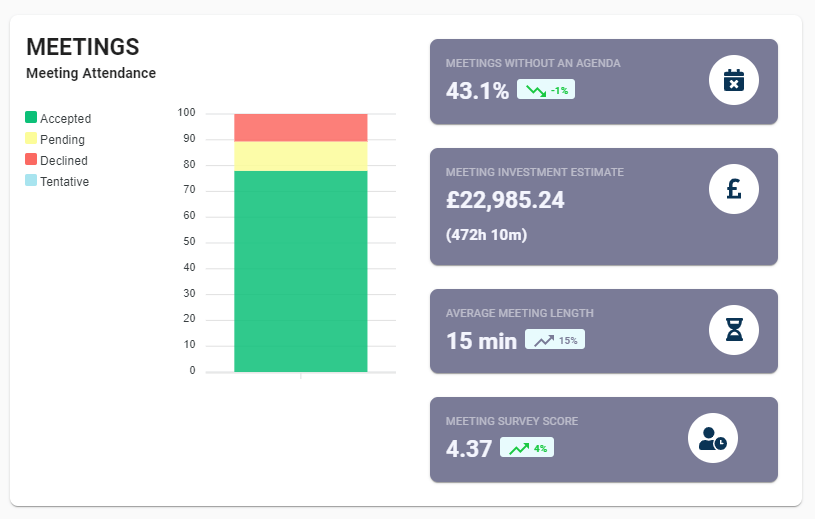A virtual work life can be hard to manage. Achieving a healthy work-life balance is essential.
Part of finding a good balance is to address the problem of virtual meeting overload. By reducing meeting overload, you'll be able to manage your time better and avoid the stress of remote meetings.
In this article, we'll take a look at some ways to overcome meeting overload and virtual meeting fatigue. Hopefully, these tips can help you ensure a more productive and balanced team meeting culture.
The first step is to identify and eliminate any potential source of meeting overload. While many companies are inclined to hold meetings as a way to keep in touch, a recent study by Microsoft found that people are more likely to multitask during a virtual meeting compared to a face-to-face one.
According to the study, a third of virtual meetings involve opening files and checking emails. The longer the meeting is, the more likely people are to multitask.
A second step to preventing remote meeting overload is to avoid excessive meetings. Overcoming this problem is essential for employees and managers alike.
Too many meetings lead to a loss of time for employees. They must prepare for them and respond to emails. They also tend to miss work hours, which is an important issue for managers.
The key is to make your remote meetings as short as possible, and to avoid involving too many people at one time.
What is meeting overload?
Simply, meeting overload is the term used for 'too many unproductive meetings or the burn-out caused by attending unproductive meetings'. The pandemic has fueled a dramatic increase in unproductive meetings and virtual meeting fatigue.
Every unproductive meeting impacts our ability to focus on important tasks and our deep work time, they breed employee disengagement and impact business performance through lost productivity.
According to a survey of more than 10,000 managers conducted by [Jigsaw], the typical employee spends at least 4 hours per week in meetings and about half of employees spend at least 8 hours per week in meetings.
Attending too many can be highly stressful and tiring, and both productivity and quality take a hit when employees tune out, become demotivated, and lose valuable heads-down work time. As such, it’s hardly a surprise that managers in one survey reported 83% of the meetings on their calendars were unproductive.
Harvard Business Review

What causes meeting overload?
One of the most common reasons we end up attending too many meetings is FOMO, otherwise known as the Fear of Missing Out. As meeting participants, we worry that our colleagues or managers will judge us — or worse yet, forget about us — if we don’t accept every invitation.
This goes hand in hand with trust issues, where many employers view presence as productivity. If your workplace culture or manager doesn't avoid harmful behaviors, the amount of of unproductive meetings you attend will increase.
Interestingly, meeting FOMO is not just limited to attendees — it can affect organizers as well, resulting in excessively inflated invite lists.

How do we decide to attend or decline a meeting
If you want people to participate in a productive meeting, let attendees know a clear purpose for every meeting. This will make the process of participation more engaging for everyone, and attendees will accept the invite because they see value in attending.
By setting an agenda everyone is clear about the objectives of the meeting. Without an agenda it makes it more difficult to decide if the meeting is relevant and should be attended.
What are the most common reasons for declining meetings?
The most common reason for declining a meeting is still....No Reason. By hitting the decline button you don't need to give a reason for declining, but by doing this simple action you are not giving the organizer any feedback, which means you will probably be invited to more irrelevant or unproductive meetings.
We don’t think people should just decline a meeting invite, but also decline the meeting invite in writing. This gives the organizer feedback about their meeting, agenda, and attendance selection to improve.
"I don’t have time for this right now."
“I have more important tasks to do.”
“I have a deadline coming up.”
“I am too busy to attend.”
“I will try to attend, but might join late.”
In our experience, these are the most common ways to decline a meeting invite.
We have created a 'Meeting Best Practice Guide' which can help you have more productive meetings.

The Benefits of Meeting analytics to reduce meeting overload

Meeting analytics and feedback can identify the characteristics that are mostly correlated with meeting decline.
As a first step, meeting analytics can look at the frequency with which we decline certain types of meetings, compared to the overall number of meetings we attend per month.
This type of meeting analysis is based on the assumption that meetings that we are more prone to decline are also the ones that we are most likely to attend less frequently.
We have highlighted some examples of how meeting analytics can change perceptions and assumptions about your meeting culture helping you identify meeting overload and unproductive meetings:
- Meetings with superiors: Compared to the overall number of meetings we attend per month, we decline almost twice as many meetings with superiors. The reason for this is that we perceive them as more prone to be declined. The implication is that, as we tend to decline meetings with superiors more often, we should try to lower the number of meetings with superiors that we are prone to decline.
- 1 on 1 meetings: Compared to the overall number of meetings we attend per month, we decline almost half as many 1:1 meetings. We tend to decline more 1:1 meetings than any other type of meetings, as we perceive them as less important. However, the results of meeting analytics suggest that this perception is not justified, as we actually decline fewer 1:1 meetings than any other type of meetings.
- Team meetings: Compared to the overall number of meetings we attend per month, we decline assume team meetings have the higher attendance rate. However meetings analytics has shown that team meetings have the second highest meeting decline rate.
- Meetings conducted online: Compared to the overall number of meetings we attend per month, we assume virtual meetings are the shortest length. However meeting analytics has shown they have the second highest meeting length and the highest agenda-less meeting rate.
These simple examples show how assumptions and perceptions about company meetings are rarely the reality. To learn more about the benefits of calendar and meeting analytics you can read this recent article, read more about our meeting culture solution, or if you would like to see our platform in action you can take a tour of our platform.
